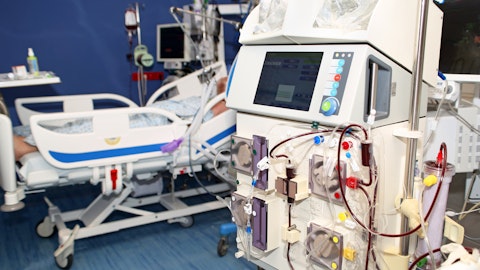Isaac Zacharias: So, the account basis, we will end the year, there is probably 20% of the accounts, but those accounts that will have launched are certainly oversized in terms of the amount of volume they do. And so still, though a vast minority of PCIs will – in the accounts we launched this year, which we expect to end the year at about 300. We will still be doing a small minority of PCI. And then as we roll through next year, that starts to get us into kind of towards the end of next year where we can get access for the accounts launched in the first 2 years to a majority of PCI.
Imron Zafar: Okay. Thank you so much.
Operator: Our next question comes from the line of Michael Polark with Wolfe Research. Please proceed with your question.
Michael Polark: Hey. Good afternoon. Thank you. I just want to drill down on U.S. peripheral again, sorry. And if you said it, I missed it, I have been juggling calls. But sequentially for the fourth quarter, U.S. peripheral revenue, do you still expect it to grow with normal seasonal pattern, or do you think this prior auth dynamic rolling through kind of contributes to flattish or down, what’s your best guess for U.S. peripheral in the fourth quarter?
Doug Godshall: Yes. Our guess to be conservative is probably better to assume flattish than much growth in this quarter as we sort of we didn’t see the rebound in September that we normally see and didn’t really see it through October. So, I think it’s safer to assume flattish.
Michael Polark: And then the into ‘24 this dynamic, a headwind, but you are launching two new products, the tailwind sounds like Street is too high. But I guess in the context of blessing $920 million for the Street next year for total company revenue, that’s up about 26%, 27% U.S. peripheral would be growing below that. Is that a fair starting point? And I guess just to be more precise, are you willing to put a kind of floor in for U.S. peripheral growth for ‘24?
Doug Godshall: It will grow below corporate average. I think that’s a safe assumption as we are modeling it out right now. And U.S. coronary and international coronary will grow well above that average.
Isaac Zacharias: And I would just say, as you know, we service the – actually globally, we service our business with one sales force. And so they need to be facile in both coronary and peripheral. But what happens in that scenario is we don’t have – we can add an expense and add another sales force, in which case you could keep pushing hard on everything equally. But when you have a single sales force, we tend to toggle effort, lean into something one quarter or two quarters then lean into something else. And over the last six quarters, eight quarters, we have been leaning into peripheral launches with both M5 and L6. And as we have turned into September, like I said on the call and first half of next year, we are going to have a lot of focus on the coronary C2+ launch in the U.S. So, we think there is going to – we expect a lot of momentum coming through with coronary.
And hopefully, this minor headwind we have with the pre-op and the goes away, in which case, peripheral start sailing a little bit more.
Doug Godshall: And the E8 will launch in the back half of next year and JAVELIN is probably more like early ‘25 as we shared a couple of weeks ago. So, below the below-the-knee starts to really contribute back into next year.
Operator: Our next question comes from the line of Mike Kratky with Leerink. Please proceed with your question.
Mike Kratky: Hi everyone. Thanks for taking our questions. First, can you just confirm whether your longer term guidance through 2026 consider the weakness in peripheral and the impact in China for anticorruption? Would you be willing to reiterate that 25% revenue CAGR?
Doug Godshall: Yes.
Mike Kratky: Great. And then as a separate one, first full quarter of Neovasc producer sales post acquisition, how does that compare to your internal expectations? And what are the catalysts or initiatives that you think are really going to help drive an inflection in sales for that product ahead of U.S. launch in ‘27?
Doug Godshall: So, in the past, we have described this – the phase we are in right now with Reducer as sort of figuring out the model, figuring out referral pathways. understand in advance of the COSIRA II data, which we think is going to be very important for our international business, obviously critical for U.S. because we have got a win on that trial to get U.S. approval. But as we understand in the markets where we can play right now, which is the UK, France and Germany, what does it take to build a robust business. And as I have described earlier, the UK team is doing a really good job of figuring that out. We have had to work through to figure out who else on the international team in the other two markets are working hard to figure that model out.
And so we are in the process of restructuring, hiring a new team in both Germany and France, where there is currently adequate payment. And they will be up and running next year, which we think will be similar to growth. If everybody were performing at the level of the UK team, you would be seeing a nice growth rate. So, that’s our sort of expectation is we will have a Shockwave team versus an inherited team other than the inherited team in the UK that were really impressed with so far.
Mike Kratky: Understood. Thanks very much.
Operator: Our next question comes from the line of Danielle Antalffy with UBS. Please proceed with your question.
Danielle Antalffy: Hey. Good afternoon guys. Thanks so much. Specific in the questions, and sorry to harp on the peripheral thing, you guys are probably tired of talking about it. But just to follow-up on Larry’s question and talking about the evidence that is needed, I guess a different angle here is if this doesn’t – if this dynamic doesn’t change, does that change the great outlook or TAM that you laid out at Analyst Day at all? And I guess just curious about how physicians react to this. Is this something that eventually positions if it doesn’t change, get frustrated and I mean I am just trying to get a better understanding of is it just delaying the time of procedures because it now takes longer to get the prior authors? Is this something that could ultimately prevent physicians from really treating these patients, which is if that’s the case of really…?




